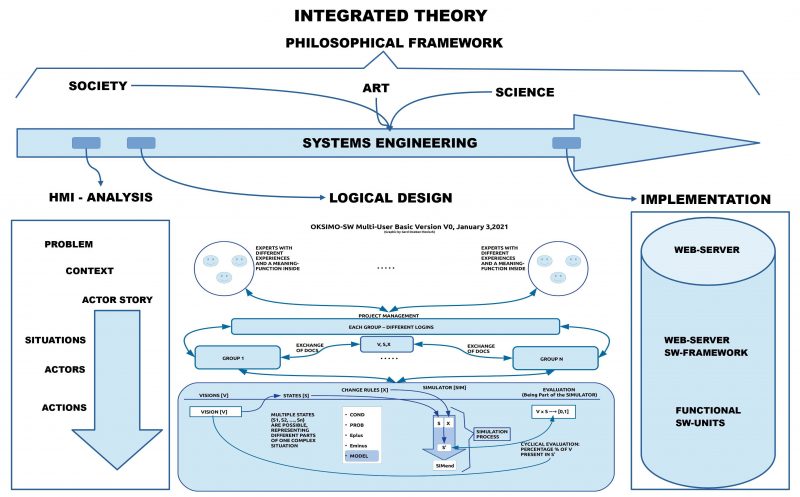eJournal uffmm.org ISSN 2567-6458, February 25, 2021
Author: Gerd Doeben-Henisch
Email: gerd@doeben-henisch.de
HISTORY
As described in the uffmm eJournal the wider context of this software project is an integrated engineering theory called Distributed Actor-Actor Interaction [DAAI] further extended to the Collective Man-Machine Intelligence [CM:MI] paradigm. This document is part of the Case Studies section.
HMI ANALYSIS, Part 1
Introduction
Since January 2021 an intense series of posts has been published how the new ideas manifested in the new software published in this journal can adequately be reflected in the DAAI theoretical framework. Because these ideas included in the beginning parts of philosophy, philosophy of science, philosophy of engineering, these posts have been first published in the German Blog of the author (cognitiveagent.org). This series of posts started with an online lecture for students of the University of Leipzig together with students of the ‘Hochschule für Technik, Wirtschaft und Kultur (HTWK)’ January 12, 2021. Here is the complete list of posts:
In what follows in this text is an English version of the following 5 posts. This is not a 1-to-1 translation but rather a new version:
HMI Analysis as Part of Systems Engineering

As described in the original DAAI theory paper the whole topic of HMI is here understood as a job within the systems engineering paradigm.
The specification process is a kind of a ‘test’ whether the DAAI format of the HMI analysis works with this new application too.
To remember, the main points of the integrated engineering concept are the following ones:
- A philosophical framework (Philosophy of Science, Philosophy of Engineering, …), which gives the fundamentals for such a process.
- The engineering process as such where managers and engineers start the whole process and do it.
- After the clarification of the problem to be solved and a minimal vision, where to go, it is the job of the HMI analysis to clarify which requirements have to be fulfilled, to find an optimal solution for the intended product/ service. In modern versions of the HMI analysis substantial parts of the context, i.e. substantial parts of the surrounding society, have to be included in the analysis.
- Based on the HMI analysis in the logical design phase a mathematical structure has to be identified, which integrates all requirements sufficiently well. This mathematical structure has to be ‘map-able’ into a set of algorithms written in appropriate programming languages running on an appropriate platform (the mentioned phases Problem, Vision, HMI analysis, Logical Design are in reality highly iterative).
- During the implementation phase the algorithms will be translated into a real working system.
Which Kinds of Experts?
While the original version of the DAAI paper is assuming as ‘experts’ only the typical manager and engineers of an engineering process including all the typical settings, the new extended version under the label CM:MI (Collective Man-Machine Intelligence) has been generalized to any kind of human person as an expert, which allows a maximum of diversity. No one is the ‘absolute expert’.
Collective Intelligence
As ‘intelligence’ is understood here the whole of knowledge, experience, and motivations which can be the moving momentum inside of a human person. As ‘collective’ is meant the situation, where more than one person is communicating with other persons to share it’s intelligence.
Man-Machine Symbiosis
Today there are discussions going around about the future of man and (intelligent) machines. Most of these discussions are very weak because they are lacking clear concepts of intelligent machines as well of what is a human person. In the CM:MI paradigm the human person (together with all other biological systems) is seen at the center of the future (by reasons based on modern theories of biological evolution) and the intelligent machines are seen as supporting devices (although it is assumed here to use ‘strong’ intelligence compared to the actual ‘weak’ machine intelligence today).
CM:MI by Design
Although we know, that groups of many people are ‘in principal’ capable of sharing intelligence to define problems, visions, constructing solutions, testing the solutions etc., we know too, that the practical limits of the brains and the communication are quite narrow. For special tasks a computer can be much, much better. Thus the CM:MI paradigm provides an environment for groups of people to do the shared planning and testing in a new way, only using normal language. Thus the software is designed to enable new kinds of shared knowledge about shared common modes of future worlds. Only with such a truly general framework the vision of a sustainable society as pointed out by the United Nations since 1992 can become real.
Continuation
Look here.
